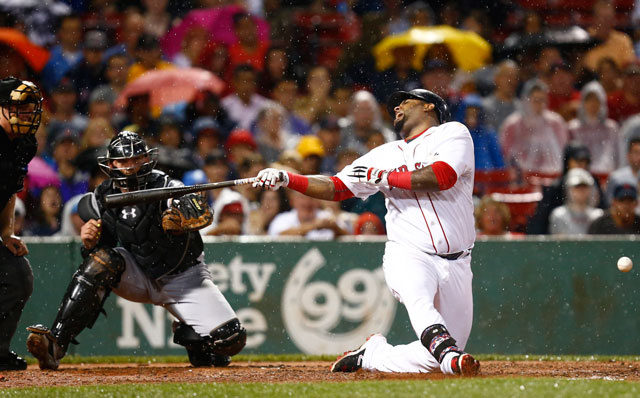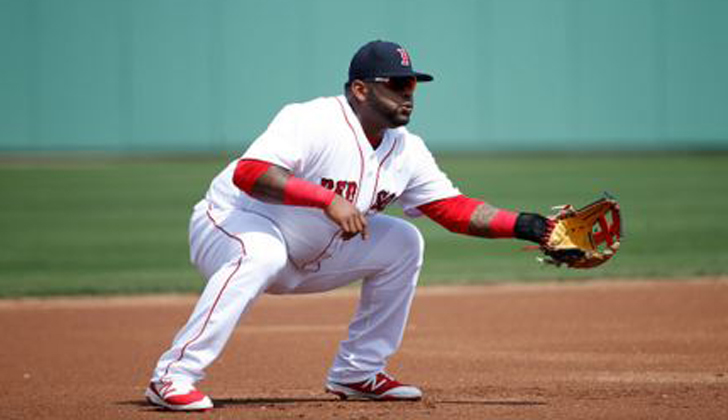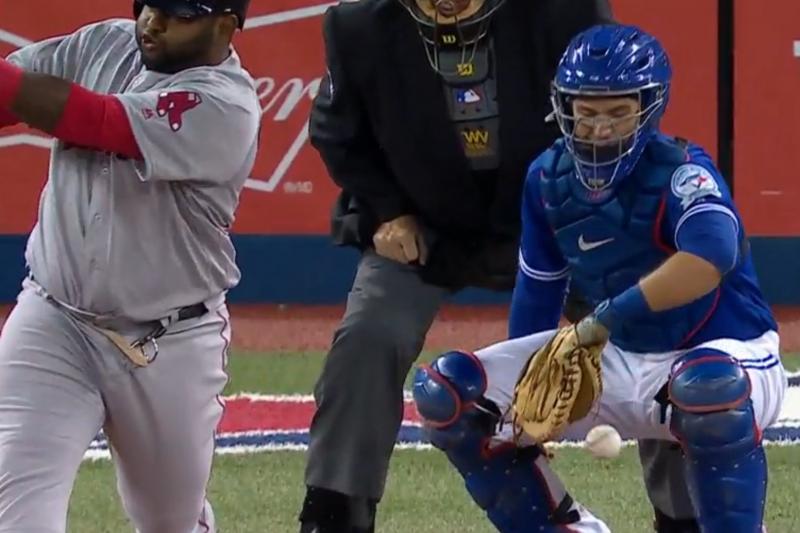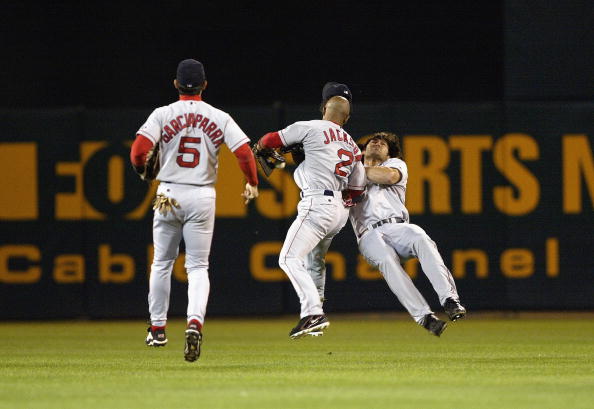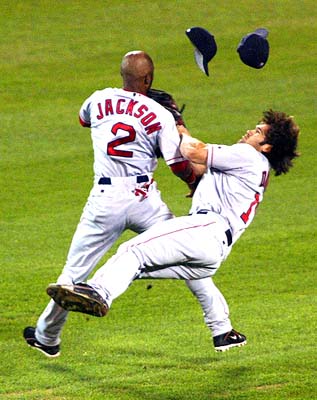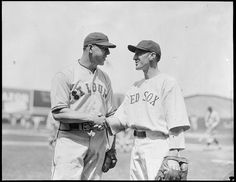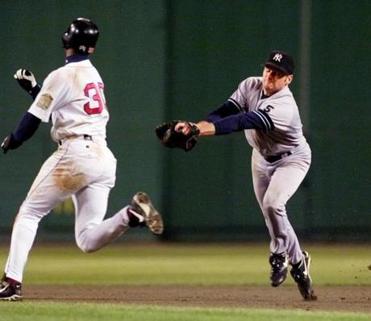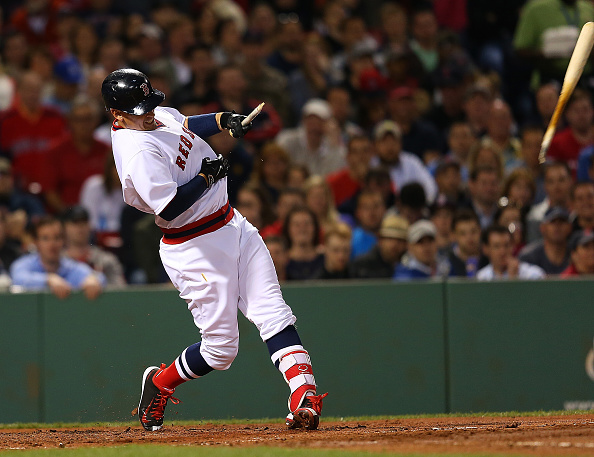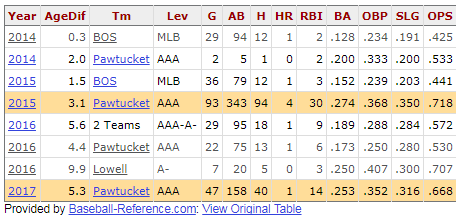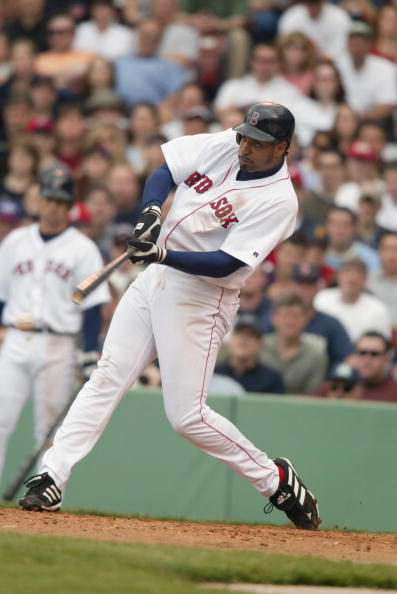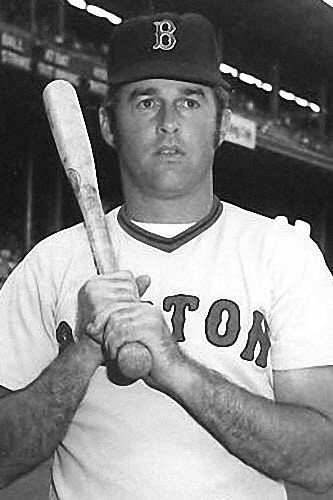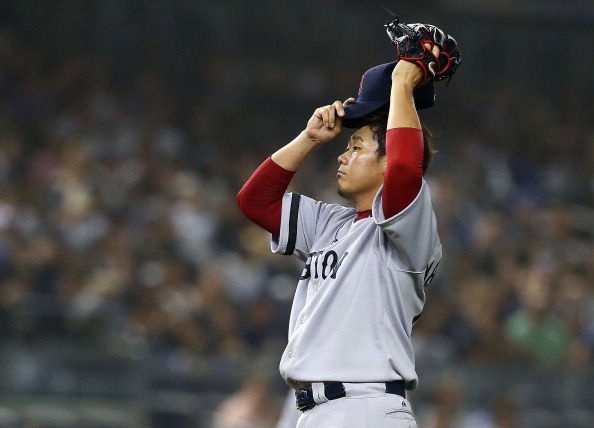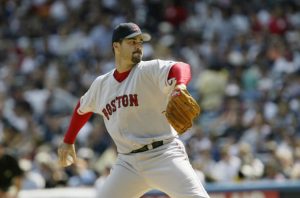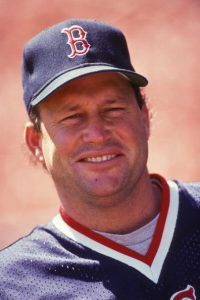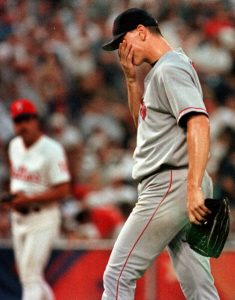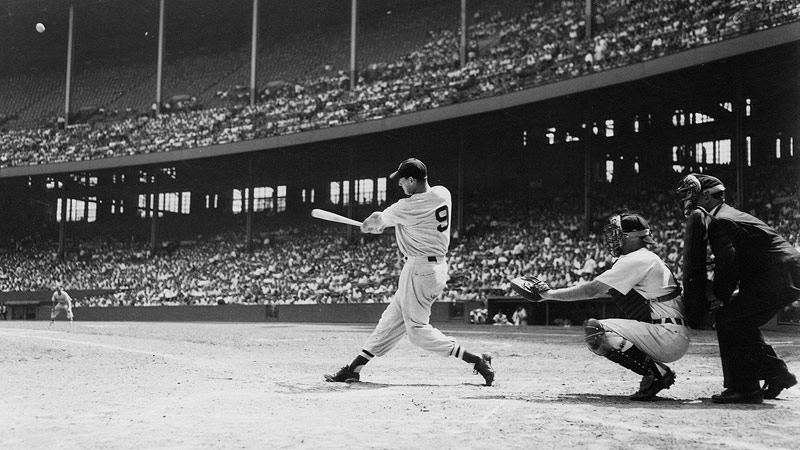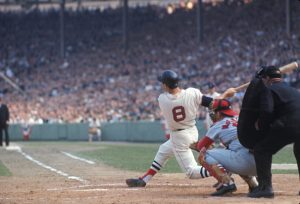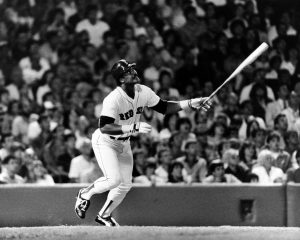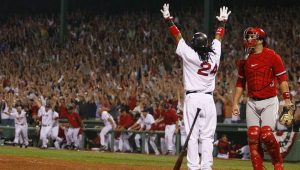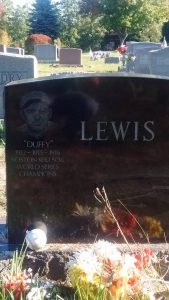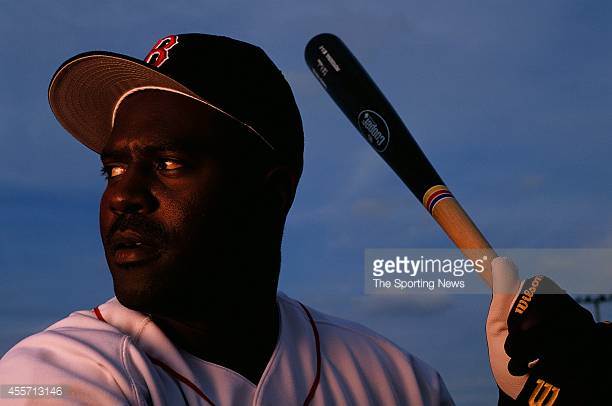The other day I had the privilege of speaking with former Red Sox player Reggie Jefferson. Reggie played parts of nine seasons in the big leagues, the final five of which were spent with the Red Sox. He batted .300 for his career, a rare accomplishment in the grand scheme of baseball history. I spoke with him about his playing days, the way the game has changed and what he is doing nowadays.
The Early Years
Reggie’s career began in Cincinnati before quickly moving cross state to the Cleveland Indians. In Cleveland he wore number 44 in honor of Hank Aaron. Eventually, he would settle on number 18 for most of his career to honor a friend back home who had become like a big brother to him.
Reggie was traded from Cleveland after the 1993 season in a deal that would net the Indians Omar Vizquel, a man I think should be making the Hall of Fame in the coming years. Reggie said when he runs into Cleveland fans he tells them they should love him because he helped bring the club Omar Vizquel. Vizquel, one of the all-time greats defensively at short, blossomed as a hitter for the Indians. Meanwhile, Reggie viewed this as a chance for more playing time. The move also reunited him with Manager Lou Piniella, who he had been with in Cincinnati. As he pointed out, Seattle had Alex Rodriguez coming up through the minors and viewed Vizquel as being expendable. But Piniella must have liked what he had seen from his one-time rookie.
Hitting Stride
Jefferson’s breakout started that season in Seattle. He batted .327 with an excellent .935 OPS before the strike hit. He credits Lou Piniella a lot for his newfound success at the plate. Piniella helped him make changes at the plate; adjust his hands to help put him in a better position to get hits.
That season Reggie abandoned switch hitting. He had switch hit through the minors with good success, hitting for similar averages from both sides of the plate but with more power from his natural left side. However, in the Bigs there were always good right-handed options on the bench. With limited at-bats from the right side, Reggie had a hard time finding a groove. Without finding a rhythm from that side of the plate, his swing became long and he felt like he gave away at-bats. Despite the advice from Eddie Murray to not give up switch-hitting, Reggie would not get the reps needed from the right side to succeed so he made the decision. He says “I think if given the chance to play every day, I think I could have hit.”
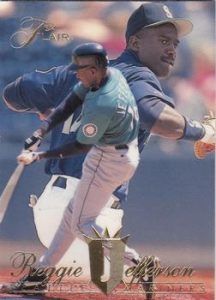
Boston
In 1995, Reggie’s agents let him know that the Red Sox signaled the most interest. Reggie was thinking, “What are they doing? They have Mo (Vaughn) and Jose (Canseco)”! The Red Sox didn’t seem to have a spot for another first baseman and designated hitter such as Jefferson. When asked if he felt like he just needed an opportunity to play and prove himself, Reggie said “definitely, that’s it. I tell clients, first need an opportunity, then need to take advantage of it.” When the opportunities came, Reggie didn’t miss them.
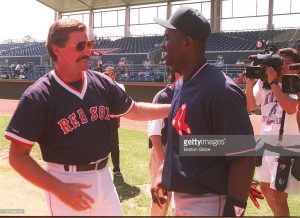
Manager Kevin Kennedy was happy to greet the newest arrival in camp, Reggie Jefferson. (Photo by Barry Chin/The Boston Globe via Getty Images)
In 1996, Jefferson had his finest season. He got to play for the injured Jose Canseco for a while, then after Jose came back the Red Sox left fielder Mike Greenwell went down. Since Reggie had been hitting so well, Manager Kevin Kennedy wanted to find a way to keep his bat in the lineup. Kennedy went to Jefferson and asked him if he’d ever played left before. Reggie lied. He told Kennedy he had, despite never before playing there. It worked out great for both parties, the Red Sox came storming back with a strong second half and Reggie finished with a .347 batting average, the fifth-highest mark in all of baseball. When asked about that season in particular, Reggie said he just felt good all year. He swung the bat great, felt comfortable at the plate and hit the ball hard.
Starting with that season, Jefferson became a fixture in the Red Sox lineup for several seasons against right handers. He’d bat over .300 in three consecutive seasons and batted .316 as a Red Sox. He was a career .345 hitter at Fenway Park with a .928 OPS. He says Fenway “just played into [his] natural strengths. The Monster rewards hitters for going the other way and there’s lots of room in right.” This fit Reggie perfectly as he just hit the ball wherever it came in over the plate, using the entire field.
Friendly Fenway
Another aspect of Fenway Park we discussed is the atmosphere. According to Reggie, the Sox have the greatest fans in the world, not only in the support shown at the park, but in the way we follow the game. Fans in Boston have a knowledge of what’s happening with the team on a day-to-day basis. He found himself cheering hard for the Sox in 2004 when they finally won the World Series. Reggie identifies more with the Red Sox than any other team because of the fans. He says there were always high expectations playing in Boston, but that he performed well. Although a bad back that first cropped up in 1990 slowed him down in 1995 and 1998, he “didn’t leave anything on the table.” He always gave it his all and performed at a high level.
I asked Reggie which game, if any, stood out in his memory. He instantly brought up a game played on Father’s Day in 1996. As he said, the Red Sox had been winning but then gave up the lead. After Mo Vaughn and Jose Canseco picked up their fourth hits of the game to begin the 9th inning, Reggie came to the plate. The Sox were trailing by two, two men on, no one out. Facing Mike Henneman, Reggie hit a line drive to the opposite field up over the Monster and into the screen. A walk-off home run in Fenway Park, and on Father’s Day to boot. Reggie was thinking of his Dad and how he had gotten him started in the game of baseball.
Reggie also brought up playing with greats like Pedro Martinez, Roger Clemens and Mo Vaughn. He referenced Pedro’s 17 strike out, one-hit gem at Yankee Stadium. Reggie left the park that night thinking “that’s the best game I’ve ever seen pitched.” He thinks it’s pretty cool nowadays when guys like Tim Kurkjian bring up that game as possibly being the greatest pitching performance ever.
Modern Baseball
We talked some about recent rule changes to the game of baseball and whether they improve the game. He does believe the rules protecting players from injury top the list. No need exists for someone to get injured on a take-out slide at second or a catcher run over at the plate. Eliminating those plays and keeping players on the field are for the best. However, he does not like the rules trying to speed up the game; “Baseball is a slow game, I don’t think going to change that much. It’s going to take 2.5-3.5 hours to play.”
As for all the home runs hit this year, we had a discussion about that. Reggie believes there is something up with the balls. Going to games at Tropicana Field, which has been known as a pitcher’s park in the past, he sees balls flying out this year. He says “some balls are getting way out that back in the day wouldn’t even get out [at all]. I see balls there I’m like, how did that get out?!” I’ve been thinking the same thing, Reggie. Balls are just flying out with too much ease. It’s not normal. He says some of it is bad pitching, guys missing their spots, but the balls must be different.
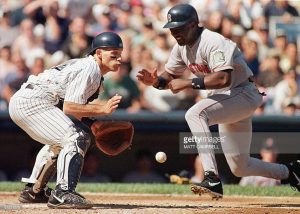
Reggie thinks plays like this, where he is about to run over Joe Girardi trying to score, are not necessary in the game.
Reynolds Sports Agency
We finished up talking about what he is up to nowadays. Reggie works for Reynolds Sports Agency, representing clients in professional baseball. It’s a more tightly knit group than some other agencies, and despite being all under one umbrella, he says you definitely get to forge relationships.
Reggie is excited for the future; they represent a left-handed reliever in Atlanta, Sam Freeman, enjoying a breakout year. Reggie says he has learned to harness his stuff and is having a terrific season. He brought up Keon Broxton and Mallex Smith as two young players on the verge of becoming household names. Reggie has known both of them since the 11th grade, illustrating the point about forging relationships. Another young guy he mentioned was Andrew Toles, who has been out almost the whole season with a torn ACL. Reggie says he’s a great hitter and will show that in the future.
The agencies biggest star is Justin Upton, who still has four years and $88.5M left on a six-year contract. However, rumors claim he might choose to opt out of the contract, as is his right after the season. Despite the rumors, Reggie denies talks about it, let alone making a decision. Justin is focusing on trying to get the Angels into the playoffs. If he does opt out, he’s having a huge year at the right time, bashing 35 homers.
Final Thoughts
I asked Reggie if his playing days help him out in his career as a sports agent. Reggie said, “Without a doubt. I know what they’re going through, I can be in their mindset.” He tells them one day they are going to get their shot, and they have got to run with it. He says at times during his own career he felt the need to talk to someone who had been there. Now, he can give that needed counsel to his clients. The job is a lot of work, keeping his plate full and requiring him to travel a lot. Reggie enjoys it though, he gets to help guys out who are just getting started in their professional careers.


